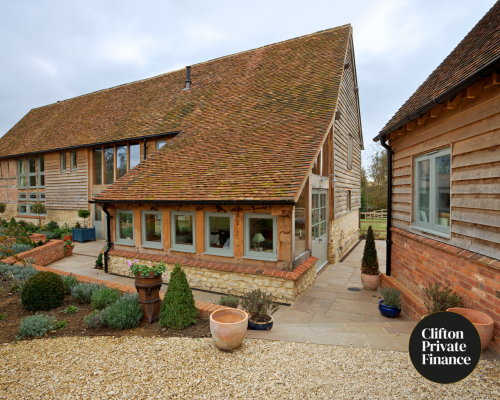Categories
Unregulated Bridging Loans - 6 Things you need to know

Unregulated bridging loans typically offer more flexible loan terms and quicker turnaround times - but how else do they differ from regulated bridging loans?
Unregulated bridging loans are short-term financial solutions commonly used to provide funding until longer-term financing can be secured or an asset is sold. Unlike regulated bridging loans, which are overseen by financial authorities and subject to strict guidelines, unregulated bridging loans do not fall under the same level of scrutiny and are not subject to the same regulations.
Need an Unregulated Bridging Loan?
Get started with our calculator
Contents
What Is an Unregulated Bridging Loan?
What Can Unregulated Bridging Finance Be Used For?
Regulated vs Unregulated Bridging Loans
Are Unregulated Bridging Loans Safe?
Benefits of Unregulated Bridging Loans
What Are the Criteria for Unregulated Bridging Finance?
What Is an Unregulated Bridging Loan
An unregulated bridging loan is a bridging loan used to buy a property that will not be used by the borrower or their family as their place of living.
So for example:
- A bridging loan to buy a house to refurbish and flip for a profit.
- Or a bridging loan for a buy to let property (bridge to let) or HMO that will be rented out and later refinanced on a standard BTL mortgage.
If you're a landlord or you intend to buy a property to rent it out, it's important to know the new government changes to EPC guidelines.
You can also get regulated bridging loans. These are bridging loans used to buy residential property that the borrower, or their family member(s), intends to live in.
For example:
- Buying a new home before selling their current house.
- Or buying a property at auction with an auction bridging loan (28 window to complete means you often need quicker finance than a normal mortgage) to later refinance on a standard mortgage.
See the latest market news below.
2025 Bridging Market Update
The bridging market has had quite a transformation in the past few years. With rates starting at 0.55% per month, the costs aren’t dissimilar from those of a mortgage, and the combination of flexibility, quick turnaround time and less stringent eligibility criteria has led to bridging finance growing in popularity.
It’s now seen as a product in its own right instead of an expensive alternative to long-term finance.
Our finance brokers are seeing more repeat clients, particularly investors who have turned their attention to property flipping considering the slim profit margins the buy to let market has been seeing. HMO conversions have also grown in popularity amid more rigid rental legislation.
According to our team of advisers, a high volume of first-time borrowers already have an understanding of bridging loans before approaching us, showing that bridging is becoming more recognised in the industry.
As bridging finance becomes more mainstream, lenders are reviewing and reducing rates more frequently, offering more flexibility around costs.

Fergus Allen
Head of Bridging
Let us do all the hard work of finding the right bridging lender for your circumstances.
We secure bridging finance for applications of all types, and we negotiate competitive lending to meet your needs and timescale.
A bridging loan is a short-term financial solution; primarily used for property purchases. The function of a bridge loan is typically, and most commonly, bridging a gap in finances when funds are otherwise unavailable.
Bridge loans are useful for those wanting to purchase a property while awaiting their previous property to sell. Often, bridge loans are the only quick and flexible alternative to a mortgage.
But what about the unregulated part?
This simply means the bridging loan is not regulated by the FCA.
While it sounds as if this may be an unsafe, or risky, type of loan – it just means that unregulated bridging loans offer greater flexibility in usage, and may have fewer restrictions in place for those already accustomed with the process and purposes of bridging finance.
With unregulated bridge loans, borrowers can secure a loan through different types of property, such as residential, commercial or semi-commercial (1st and 2nd charge) – whereas a regulated loan is only used in residential property transactions, and the loan must be secured by a residential property.
See similar: What is a Bridge Loan?

What Can Unregulated Bridging Finance Be Used For?
Unregulated bridging finance is primarily used in property transactions but with greater scope than a regulated bridging loan.
A regulated bridge loan may be more suitable to the average borrower looking to either; fund an investment property purchase, resolve a chain break in a property chain, or refurbish a property.
With unregulated bridge loans, there are many more uses as it’s applicable to many different scenarios.
Here are some of the common uses of unregulated bridge finance:
- Property Development – an unregulated bridge loan can fund development, renovations or large scale conversions for residential or commercial use. A loan such as this can also be used for ground-up development or a new-build project.
- Purchasing an auction property – properties at auction have strict payment deadlines in place (28 days) and can be impossible to finance with a mortgage if they are in an unmortgageable state. However, with an unregulated bridging loan, you can finance an auction property quickly – whether for commercial or residential use.
- Investment opportunities – Due to the flexibility of unregulated bridge loans, a property investor can get quick access to funds in a competitive market and snap up properties for investment, and large scale development works.
- Business loans – Unregulated bridge loans aren’t limited to property transactions. You can also fund business expenses during periods of non-liquidity. This might include; purchasing necessary machinery and equipment for your business, purchasing new business premises or expanding existing ones, or to pay a HMRC tax bill.
This is by no means an exhaustive list of uses for unregulated bridge finance, as it can be useful for many different situations (especially for those with prior experience).
However, it’s important to recognise that whether you're new to bridge loans or not, a bridging loan broker can ease the process greatly, whatever your purposes may be for a bridge loan.
At Clifton Private Finance, we can help facilitate an unregulated bridge loan through a network of lenders that may be unavailable to you as an individual.
If you’re looking for specific information and advice on how to go about getting the best bridging loan, you can take a look at our guide.
Bridging Loan Calculator
Looking for short term finance to purchase a property?
Use our UK bridging loan calculator to get an indicative quote:
Explore some of the bridging deals we've facilitated below:
Regulated vs. Unregulated Bridging Loans
The majority of loans will have some form of regulatory requirements – this is true for mortgages and certain types of bridge loans. This regulatory body is known as the FCA (Financial Conduct Authority) in the UK, and it’s in place to protect borrowers by making sure lenders adhere to certain practices and terms.
However, unregulated bridging loans do not have this same protection – but this is not something to be concerned about, as long as you understand the differences between a regulated and unregulated bridging loan and the reasons why you may want an unregulated loan instead. Here are some key differences:
- The eligibility requirements – unregulated loans may have looser eligibility requirements and will not pose the same stringent requirements as a regulated loan.
- The loan terms – unregulated loans can have more flexibility when it comes the period of repayment. They can be much shorter or longer. This will depend on the type of loan and the lender’s criteria.
- The interest rates – bridge loans in general can be expensive, with higher interest rates than mortgages which span 25-30 years. A bridge loan typically only spans under a year – however, unregulated loans may have even higher rates as they are not subject to FCA regulation and are set at a lender’s discretion.

Are Unregulated Bridging Loans Safe?
All types of loans can come with a certain level of risk – so it’s important to fully understand the terms of your loan agreement and the lender’s criteria before you embark on applying for a loan.
That being said, unregulated bridging loans can pose additional risk due to shorter repayment periods, higher interest rates and the potential to lose your collateral in the event you cannot repay the loan.
You’ll need to make sure you:
- Have a solid exit strategy (typically the security the loan is set against)
- Understand the rates, terms and costs involved throughout the duration of an unregulated bridge loan.
Risk can be offset and easily mitigated through the help of an expert – we can help you pinpoint exactly what you’ll need and can help facilitate an unregulated loan for you when it comes to the task of finding an appropriate lender.
Benefits of Unregulated Bridging Loans
The advantages of an unregulated loan come through the flexibility it can provide a borrower. Lenders can offer more with an unregulated loan, with fewer restrictions, as they are not subject to the same regulatory oversight. Applying for a bridge loan may be easier than applying for a mortgage due to less strict eligibility requirements.
- Unregulated bridge loans can also be organised very quickly – usually within a working week. This is especially useful when it comes to time-sensitive property transactions in a competitive market or development plans that need to begin immediately.
- Additionally, unregulated loans can offer higher loan amounts – although there are no real upper limits to how much you can borrow, it will depend on the security offered.
What Are The Criteria For Unregulated Bridging Finance?
Unlike traditional finance, such as a mortgage which spans years – lenders are usually not as concerned with income, credit history etc. but this can vary, and will depend on the details of any given loan.
The main criteria, of which a lender will need to verify, are:
- Having an exit strategy
- Having security for the loan
Lenders will first and foremost want to mitigate the risk of lending large amounts, and they’ll need to see sufficient security used as collateral – this is often property but can include additional assets like high-value vehicles or an investment portfolio.
The criteria for unregulated bridging finance criteria can vary from lender to lender and can change on a case by case basis.
We have a guide for those looking for more specific information on bridging loan criteria, for both unregulated and regulated bridge loans.

Need Advice With Unregulated Bridging Loans?
Here at Clifton Private Finance, we can help guide you through your options, whether you're new to bridging loans or are more experienced with this type of financing.
When making any significant financial decision, especially if you’re planning on taking out an unregulated loan, it's always best to seek the help of a bridging loan expert. With the help of our brokers, we can ensure you're getting finance at an affordable and favourable rate.
At Clifton Private Finance, we have an award-winning team of bridging brokers who can guide you through the process.
Call us today on 0117 959 5094 to see how we can help, or book a consultation with us below.

 FAQs
FAQs
How Does a Bridging Loan Work?
Bridging loans work by allowing borrowers to quickly access funds for property transactions while they are stuck in a financial gap. This allows the buyer to repay the full amount at a later date, typically through the proceeds of a property sale.
Are Bridging Loans Regulated?
Not all bridging loans are regulated. Many lenders offer unregulated bridge loans with flexible terms for purposes outside of residential property transactions. Regulated loans are subject to oversight from the FCA, while unregulated loans are not.
How Much Can I Borrow?
There are no upper limits to how much you can borrow with an unregulated bridge loan. However, it will depend on what you are able to repay via your exit strategy, which is limited by the sale of your security property or refinancing said property.
How Much Does an Unregulated Bridging Loan Cost?
Rates and overall costs will vary depending on a variety of factors - namely the lender facilitating the loan, what type of loan it is, and the loan amount.
You can use our bridge loan calculator to get a general idea of costs before you get started.




















